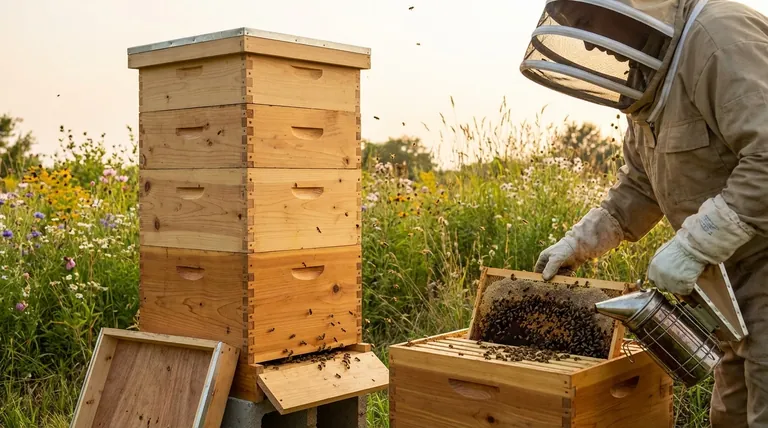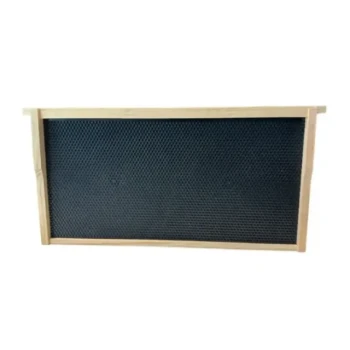At its core, a Langstroth hive consists of vertically stacked, interchangeable boxes. These boxes come in three standard depths—Deep, Medium, and Shallow—and two common widths, 10-frame or 8-frame. Traditionally, beekeepers use Deep boxes for the brood chamber where the queen lays eggs and Medium or Shallow boxes as honey supers for storage.
Your choice of box size is the most fundamental equipment decision you will make as a beekeeper. It dictates not just the structure of the hive, but the physical demands of hive management and the simplicity of your entire operation.

Deconstructing the Langstroth Box: Depth and Width
A Langstroth hive is a system of modular components. Understanding the two key dimensions—depth and width—is essential to grasping how the system works. All standard boxes share the same length and width footprint to ensure they can be stacked.
The Three Standard Depths
The depth of the box determines its vertical volume and its primary role in the hive.
- Deep (9 5/8"): This is the largest box. Its significant volume makes it the traditional choice for the brood chamber, providing ample space for the queen to lay and the colony to raise new bees.
- Medium (6 5/8"): Often called the "Illinois Super," this is the versatile, all-purpose size. It's most commonly used as a honey super, but many beekeepers use two Medium boxes together to serve as a complete brood chamber.
- Shallow (5 7/8"): This is the lightest box. It is used almost exclusively as a honey super, particularly for producing comb honey, where a smaller frame is advantageous.
The Two Standard Widths: 10-Frame vs. 8-Frame
The width of the box determines how many frames it holds, which directly impacts its weight and total capacity.
- 10-Frame: This is the original, commercial standard. It provides more space for brood and honey, potentially leading to a larger colony and a greater honey yield per box.
- 8-Frame: This is a popular modern alternative, especially for hobbyists. Holding two fewer frames, it is narrower and significantly lighter and easier to handle than a 10-frame box.
Common Hive Configurations and Their Purpose
Beekeepers combine these boxes in different ways to suit their management style and goals.
The Traditional Configuration
The most common setup uses one or two Deep boxes for the brood chamber at the bottom of the hive. As the colony gathers nectar, the beekeeper adds Medium or Shallow honey supers on top.
The All-Medium System
To simplify equipment, many beekeepers now use only Medium boxes for the entire hive. Two or three Mediums are used for the brood chamber, and additional Mediums are added on top as honey supers. The primary benefit is that every box and frame in the apiary is identical and interchangeable.
The Role of Nuc Boxes
You will also encounter smaller 4 or 5-frame boxes called "nucs" (short for nucleus hives). These are not for full-scale honey production; their purpose is to start new colonies, raise queens, or house swarms before moving them into full-sized equipment.
Understanding the Trade-offs: Weight vs. Simplicity
Choosing a hive system is a balancing act. The ideal configuration for a commercial operator may be impractical for a backyard hobbyist.
The Critical Factor of Weight
This is the most significant consideration. A 10-frame Deep box filled with honey and bees can weigh 80-90 pounds (36-41 kg). In contrast, a full 10-frame Medium super is a more manageable 50-60 pounds (23-27 kg). An 8-frame Medium is even lighter.
Hive Productivity and Volume
A 10-frame hive offers about 25% more volume per box than an 8-frame hive. This can support a larger population and potentially produce more honey, which is why it remains the commercial standard. However, a well-managed 8-frame hive can be exceptionally productive.
Equipment Simplicity
Using a single box size (like an all-medium system) eliminates complexity. You only need to buy, build, and store one size of box and one size of frame. This streamlines inspections, harvesting, and equipment rotation, which is a major advantage for any beekeeper.
How to Choose the Right System for Your Goals
Your choice should be based on your physical ability, beekeeping philosophy, and overall goals.
- If your primary focus is maximizing yield and you are comfortable with heavy lifting: The traditional 10-frame system with Deep brood boxes is the proven industry standard.
- If your primary focus is easier handling and reducing physical strain: An 8-frame system is an excellent choice, as it significantly reduces the weight of every lift you make.
- If your primary focus is operational simplicity and interchangeable parts: An all-Medium system (in either 8 or 10-frame width) is the superior option for simplified management.
Ultimately, the best hive system is the one you can manage effectively and safely for years to come.
Summary Table:
| Box Depth | Common Name | Typical Use | Key Characteristics |
|---|---|---|---|
| Deep (9 5/8") | Brood Box | Brood Chamber (Queen Laying) | Largest volume; traditional choice for the main colony nest. |
| Medium (6 5/8") | Illinois Super | Honey Super / All-Purpose Brood Chamber | Versatile, all-purpose size; manageable weight. |
| Shallow (5 7/8") | Honey Super | Honey Super (especially for comb honey) | Lightest weight; ideal for honey extraction. |
| Box Width | Frames | Key Characteristics | Ideal For |
|---|---|---|---|
| 10-Frame | 10 | Maximum volume/heavier; commercial standard. | Maximizing yield; beekeepers comfortable with heavy lifting. |
| 8-Frame | 8 | Lighter/easier to handle; narrower footprint. | Hobbyists; reducing physical strain; easier management. |
Ready to Build Your Ideal Hive System?
Choosing the right Langstroth boxes is crucial for your apiary's success and your own ease of management. At HONESTBEE, we supply commercial apiaries and beekeeping equipment distributors with the high-quality, durable components needed for any configuration—from traditional 10-frame Deep systems to streamlined all-Medium setups.
We provide the reliable foundation for your operation, offering:
- Wholesale-focused pricing on all standard box sizes and frames.
- Durable, precision-built equipment designed for long-term use in demanding conditions.
- Expert support to help you select the optimal equipment for your specific goals.
Let's discuss your equipment needs. Contact our wholesale team today to get a quote and build a more productive, manageable apiary.
Visual Guide

Related Products
- Long Langstroth Style Horizontal Top Bar Hive for Wholesale
- Solid Bottom Board Australian Pine Wood Langstroth Bottom Board for Wholesale
- Professional In-Hive Bee Feeder HONESTBEE Frame for Beekeeping
- Multi-Functional Sliding Hive Entrance for Beekeeping
- JZBZ Langstroth Queen Rearing Frame for Beekeeping
People Also Ask
- What are the most popular types of hives besides the Langstroth? Top Bar & Horizontal Hives Explained
- What is a top bar bee hive? A Natural, Low-Stress Beekeeping Solution
- What are the box management requirements for a top bar hive vs. Langstroth? Choose Your Hive Strategy
- What are the benefits of the top bar hive? A Guide to Ergonomic, Natural Beekeeping
- What are the main differences between Langstroth hives and top bar hives? Choose the Right Hive for Your Beekeeping Goals



















